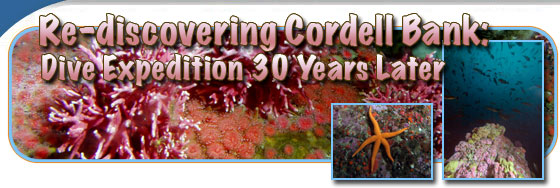Error processing SSI file
|
Blog: Oct. 9, 2010
Diving the Cordell Bank
By David McGuire, filmmaker
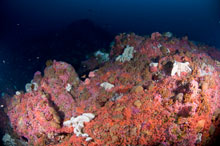 |
| Cordell Bank. Click the image for a larger view. (Photo: Joe Hoyt, CBNMS/NOAA) |
Over the past five days I have had the incredible experience of diving on a location few have ever had the opportunity: the Cordell Bank. One of the four California National Marine Sanctuaries, this undersea granite reef southwest of Bodega Bay is frequently washed by huge swells and howling northwest winds. Although it is only 22 miles from Bodega Bay, it feels as if it were a thousand miles from shore. Around us, Black-footed Albatross dip and veer, Blue whales spout and Humpback whales breach and lunge feed. The deep green waters are a cornucopia of life and literally squirm with small fish and krill. Below the deck of the NOAA vessel Fulmar rest the Cordell Bank, video camera in hand I was able to assist the team of technical divers from Sanctuaries across the nation.
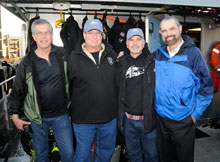 |
| Cordell Expedition Divers: Bill Kruse, John Walton, Dave Cassotta, Bob Schmieder (Photo: Bob Schwemmer, CBNMS/NOAA) |
First discovered by a sailing vessel in 1869 by George Davidson, the weathered mountain of mixed granite has been visited only a few times over the decades. The first to dive Cordell was an ad-hoc team of divers and adventurers known as the Cordell Expedition and led by Dr. Bob Schmieder. Beginning in 1977, this team of intrepid divers made the drop and recorded sea life, sampled the biota and helped map the reef's surface. This remarkable achievement has lead to important knowledge of the Cordell Bank and was instrumental in forming the National Marine Sanctuary.
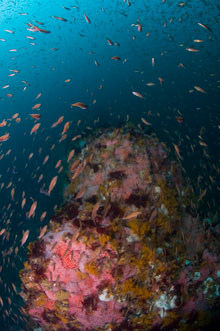 |
| Cordell Bank pinnacle. Click the image for a larger view. (Photo: Joe Hoyt, CBNMS/NOAA) |
Over several days, Bob and others from the original Cordell Expeditions team have joined us, sharing their first hand perspectives, viewing video footage brought back by the team of divers from the Grays Reef National Marine Sanctuary (NMS), the Thunder Bay NMS, the Monitor NMS and the regional Marine Heritage Office. Bob's eyes shine and his hands grip the rail and you can feel how badly he wants to join the second team of divers as they plunge in to re-assess the health and make up of the reef system two hundred feet below.
The early divers marvel at the multiple bottles of tri -mix, oxygen and nitrox gases, as well as the sophisticated dive computers and dry suits. Despite the technical advantages, the modern team still has their work cut out for them. Diving into the limited visibility, the cold water and currents is still a challenge, but everyone onboard realizes what a feat it was to first dive the Bank.
The images brought back are extraordinary, and what strikes me most is that these veteran NOAA divers who have dived all over the world, experienced natural beauty and rare submarine artifacts of our maritime heritage are as blown away by the Cordell Bank as the original expeditioneers.
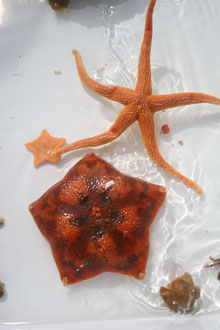 |
| The few specimens brought up are carefully handled by my colleagues at the California Academy of Sciences to describe, and with the originals from the Cordell Expeditions, will become part of the Academy collections. Click the image for a larger view. (Photo: Kaitlin Graiff, CBNMS/NOAA) |
The Bank is covered with bright red and pink Corynactis anemones, purple and pink stylaster corals, and white sponges. There is not an inch uncovered by life and over the sessile assembly swarms a cloud of rockfish, the juveniles so thick that they nearly black out the camera lens.
In an ocean of change, from overfishing to acidification, the Cordell Bank is a repository of information and a savings account for future fish and invertebrate populations, as well as an assembly point for the krill and whales above. Being able to participate in and document this expedition, to be among these ocean explorers past and present, and to see the richness of ocean life has been one the highlights of my ocean life. We are so fortunate to have the richness and abundance of marine life so close to our shore, and have the wisdom to protect it. With the abundance of high definition footage I have collected, and the tales that have been told, I intend to share this experience with the world, so we can all appreciate the Cordell Bank, and support our National Marine Sanctuaries.
|

